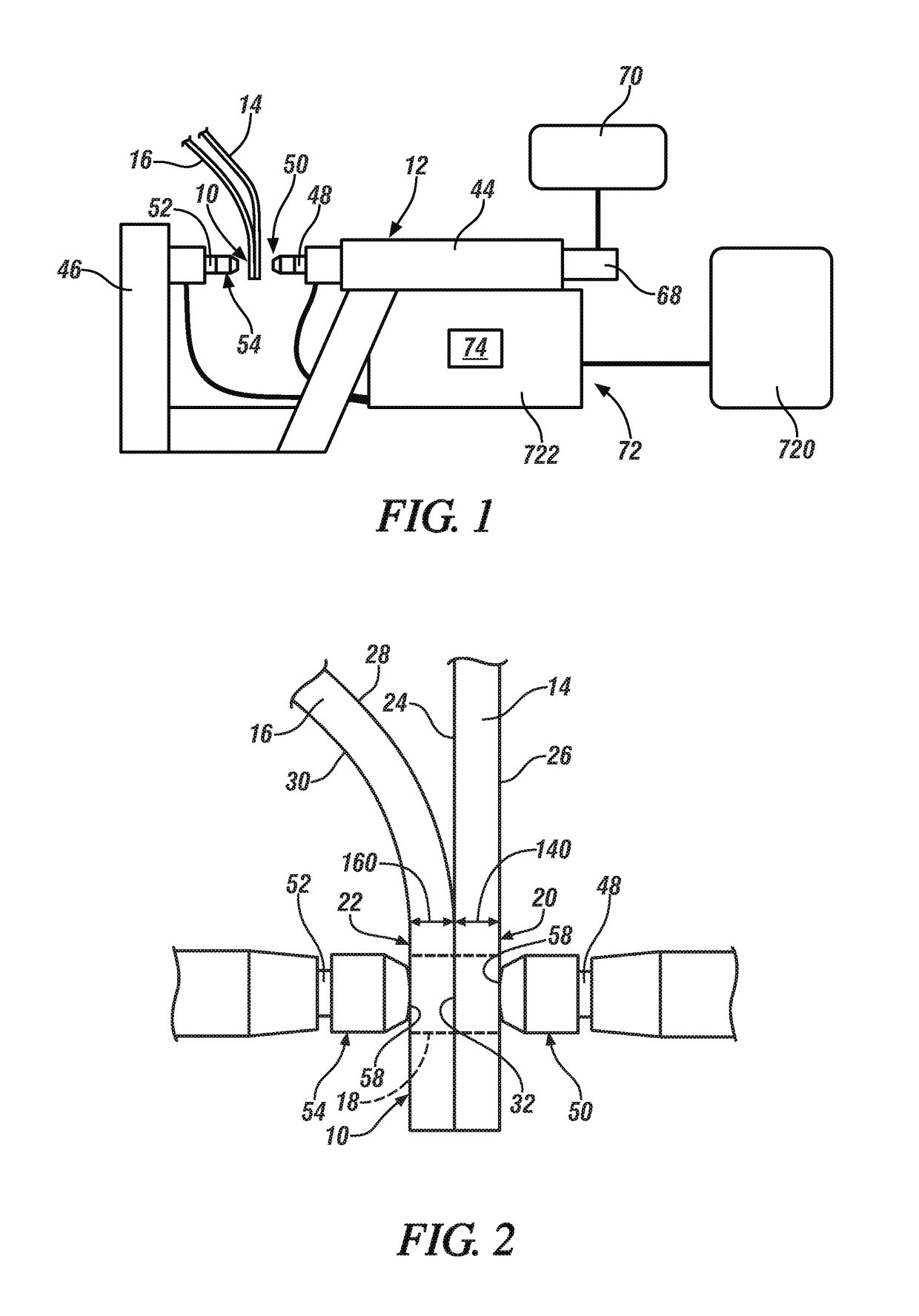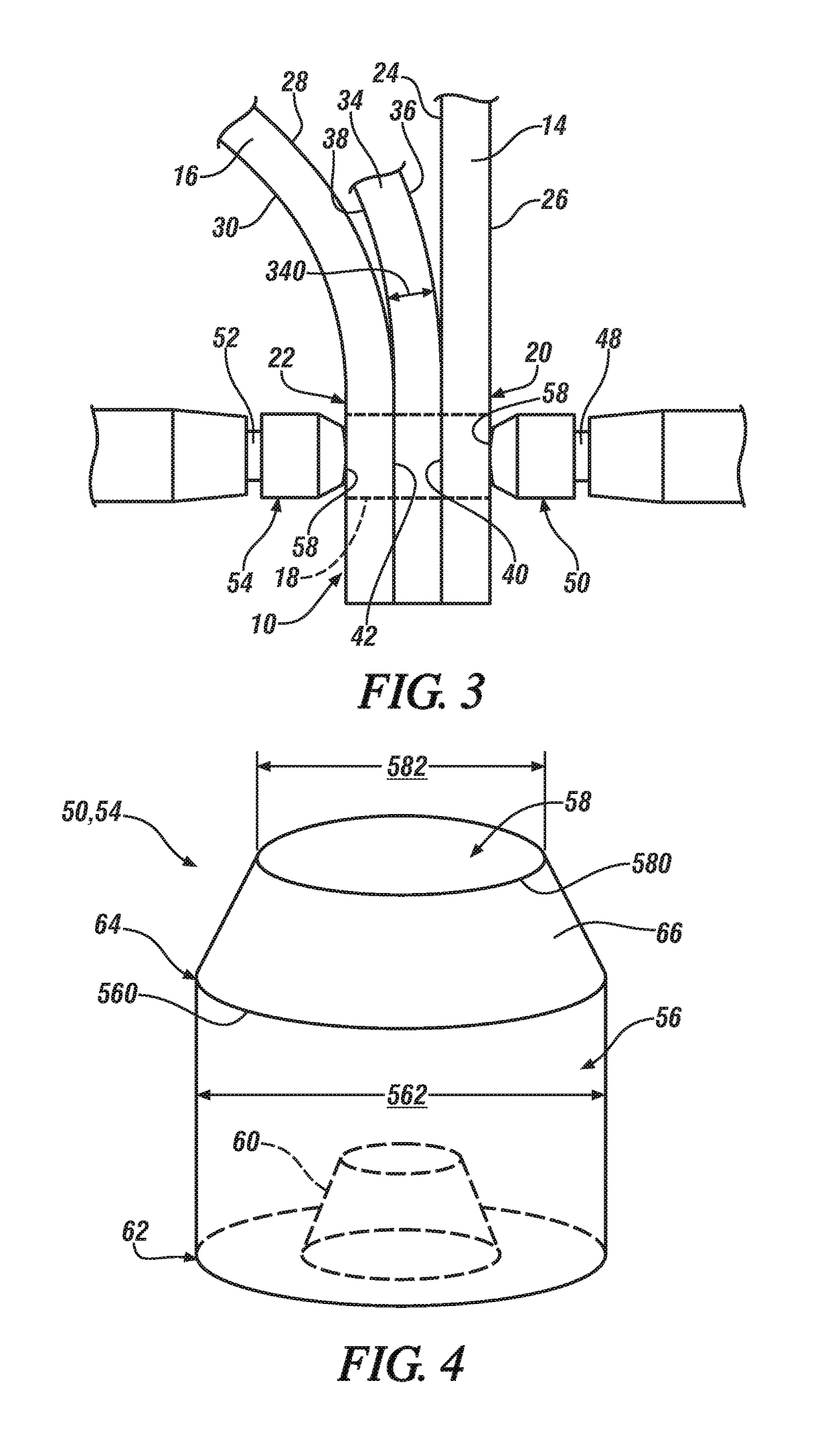Power pulse method for controlling resistance weld nugget growth and properties during steel spot welding
a technology of resistance weld nuggets and power pulses, which is applied in the direction of welding electric supplies, welding/soldering/cutting articles, manufacturing tools, etc., can solve the problem of molten steel weld pool receding
- Summary
- Abstract
- Description
- Claims
- Application Information
AI Technical Summary
Benefits of technology
Problems solved by technology
Method used
Image
Examples
example 1
[0064]In this example, which corresponds to FIG. 12, a 1.5-mm thick high-strength, uncoated PHS (1300 MPa) workpiece was resistance spot welded to a 1.5-mm thick uncoated Dual Phase steel (590 MPa) workpiece. The two workpieces were held together by DOW Betamate 1486 adhesive. During the conditioning stage of the pulsating DC electrical current, the current level was raised to 18 kA for a period of 15 ms, followed by a 10 ms cooling period (current level programmed to 0 kA). Next, during the sizing stage, the pulsating DC electrical current was programmed to include five electrical current pulses that were separated from one another by intermittent cooling periods (where the current level of the pulsating DC electrical current was programmed to 0 kA) of 10 ms. The five electrical current pulses lasted for 50 ms each.
[0065]Of the five electrical current pulses included in the sizing stage, the first four had peak current levels falling within the range of about 8-10 kA, and the peak ...
example 2
[0066]In this example, which corresponds to FIG. 13, a 1.5-mm thick high-strength, uncoated PHS (1300 MPa) workpiece was resistance spot welded to another 1.5-mm thick uncoated Dual Phase steel (590 MPa) workpiece in the same manner set forth above with respect to example 1 including the use of DOW Betamate 1486 adhesive to hold the workpieces together. One difference in this example, however, is that an internal expulsion event occurred at the faying interface during the third electrical current pulse in the sizing stage of the pulsating DC electrical current. The fact that this expulsion event occurred was not out of the ordinary and its effects on the relevant properties of the final weld nugget were not seen as detrimental. When the average applied power (identified with an “x” symbol) of each electrical current pulse in the sizing stage was subjected to simple linear regression, the resultant regression line 520 had a slope greater than zero and was represented by the equation ...
example 3
[0067]In this example, which corresponds to FIG. 14, a 1.5-mm thick high-strength, uncoated PHS (1300 MPa) workpiece, a 1.5-mm thick uncoated Dual Phase steel (590 MPa) workpiece, and a 1.6-mm thick uncoated HSLA steel (340 MPa) workpiece were resistance spot welded together. The two adjacent 1.5-mm thick workpieces were held together by DOW Betamate 1486 adhesive. During the conditioning stage of the pulsating DC electrical current, the current level was raised to 18 kA for a period of 15 ms, followed by a 10 ms cooling period (current level programmed to 0 kA). Next, during the sizing stage, the pulsating DC electrical current was programmed to include six electrical current pulses that were separated from one another by intermittent cooling periods (where the current level of the pulsating DC electrical current was programmed to 0 kA) lasting for 10 ms. The six electrical current pulses lasted for 50 ms each.
[0068]Of the six electrical current pulses included in the sizing stage,...
PUM
| Property | Measurement | Unit |
|---|---|---|
| tensile strength | aaaaa | aaaaa |
| current | aaaaa | aaaaa |
| current | aaaaa | aaaaa |
Abstract
Description
Claims
Application Information
 Login to View More
Login to View More - R&D
- Intellectual Property
- Life Sciences
- Materials
- Tech Scout
- Unparalleled Data Quality
- Higher Quality Content
- 60% Fewer Hallucinations
Browse by: Latest US Patents, China's latest patents, Technical Efficacy Thesaurus, Application Domain, Technology Topic, Popular Technical Reports.
© 2025 PatSnap. All rights reserved.Legal|Privacy policy|Modern Slavery Act Transparency Statement|Sitemap|About US| Contact US: help@patsnap.com



